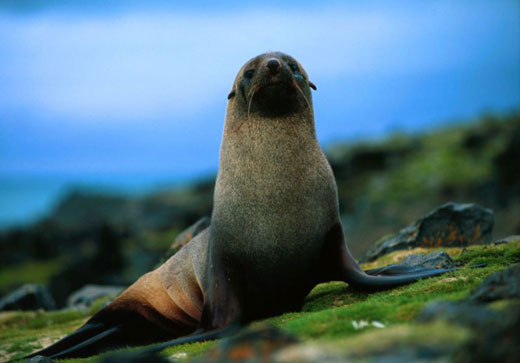Fur Seal :: WLR:- Fur seals are any of nine species of pinnipeds in the Otariidae family. One species, the northern fur seal (Callorhinus ursinus) inhabits the North Pacific, while seven species in the Arctocephalus genus are found primarily in the Southern hemisphere. They are much more closely related to sea lions than true seals, and share with them external ears (pinnae), relatively long and muscular foreflippers, and the ability to walk on all fours. They are marked by their dense underfur, which made them a long-time object of commercial hunting.
Fur seals share with other otariids the ability to turn their rear limbs forward and move on all fours. Fur seals are generally smaller than sea lions. At under 1 metre (3 ft 3 in), the Galapagos fur seal is the smallest of all pinnipeds. However, their flippers tend to be proportionately longer, their pelage tends to be darker and the vibrissae more prominent. Males are often more than five times heavier than the females, making them among the most sexually dimorphic of all mammal groups.
Fur seals share with other otariids the ability to turn their rear limbs forward and move on all fours. Fur seals are generally smaller than sea lions. At under 1 metre (3 ft 3 in), the Galapagos fur seal is the smallest of all pinnipeds. However, their flippers tend to be proportionately longer, their pelage tends to be darker and the vibrissae more prominent. Males are often more than five times heavier than the females, making them among the most sexually dimorphic of all mammal groups.
Typically, fur seals gather during the summer months annually in large assemblages at specific beaches or rocky outcrops to give birth and breed. All species are polygynous, meaning dominant males reproduce with more than one female. For most species, total gestation lasts about 11.5 months, including a several month period of delayed implantation of the embryo. While northern fur seal males aggressively select and defend the specific females in their harems, males of southern species of fur seal tend to protect spatial territories and females are free to choose or switch their mates according to their own preference or social hierarchy. After several continuous days of nursing the newborn pups, females go on extended foraging trips that can last as long as a week, returning to the rookery to feed their pups until they are weaned. Males fast during the reproductive season, unwilling to leave their females or territories.
The remainder of the year, fur seals lead a largely pelagic existence in the open sea pursuing their prey wherever it is abundant and plentiful. Fur seals feed on moderately sized fish, squid and krill. Several species of the southern fur seal also have sea birds, especially penguins, as part of their diet. The fur seals themselves are preyed upon by sharks, orcas and occasionally by larger sea lions.
When fur seals were hunted in the late eighteenth and early nineteenth centuries, they hauled out on remote islands where there were no predators. The hunters reported being able to club the unwary animals to death one after another, making the hunt profitable even though the price per seal skin was low.
The remainder of the year, fur seals lead a largely pelagic existence in the open sea pursuing their prey wherever it is abundant and plentiful. Fur seals feed on moderately sized fish, squid and krill. Several species of the southern fur seal also have sea birds, especially penguins, as part of their diet. The fur seals themselves are preyed upon by sharks, orcas and occasionally by larger sea lions.
When fur seals were hunted in the late eighteenth and early nineteenth centuries, they hauled out on remote islands where there were no predators. The hunters reported being able to club the unwary animals to death one after another, making the hunt profitable even though the price per seal skin was low.


No comments:
Post a Comment